Sourcing new content ideas can be a frustrating chore for content creators. We feel like we've tapped every bit of creativity at our disposal. Here's something encouraging about coming up with new ideas: we don't need a bolt of inspiration or an algorithm to nail the most relevant topics. We need people.
If one must go after inspiration with a club, then here are the best places on the internet to hunt—the proverbial waterholes where people and ideas congregate and where you can find your next great content idea.
1. Reddit
Reddit is an aggregation website with 48 million monthly active users as of 2021.
Users can post, comment, upvote, or downvote content. Reddit sets the visibility of posts based on the number of upvotes and the date of publication (the more recent, the more visible). Because Reddit leaves it entirely to its users to determine what others should see (unlike Facebook or Instagram), Reddit is particularly good at capturing the internet’s quick-moving zeitgeist.
Subreddits (the smaller pages that aggregate posts within Reddit) provide access to potentially millions of other people, each with their own thoughts and views on topics important to their sphere. The unfiltered and organic nature of Reddit can make it controversial, but it also makes it fertile grounds to find new ideas just waiting for you to discover them.
How to Find Content Ideas on Reddit
Start by signing up for an account so you can subscribe to and keep track of the most useful subreddits in your industry. Reddit will also aggregate popular posts from your subscribed subreddit list into your own personal feed (called your Home feed).
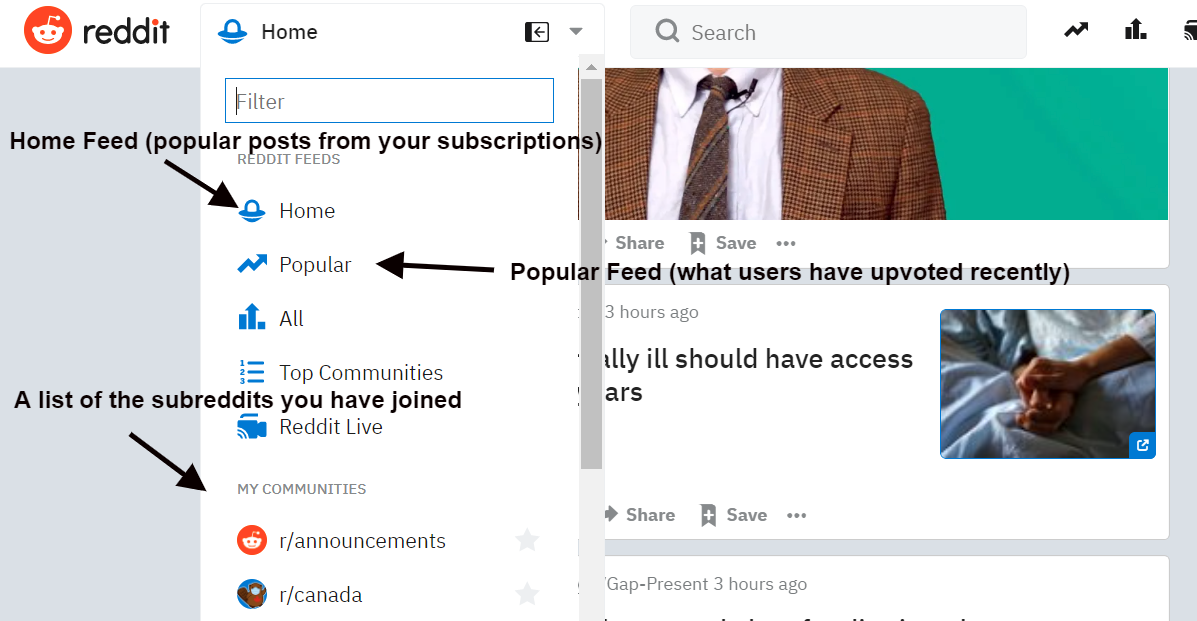
To get the most out of Reddit, you need to find subreddits dedicated to your field, places where your target audience might spend time. Here’s how.
Say you run a travel blog. You could type travel into the search bar at the top, and Reddit will auto-populate subreddits whose name has that keyword:

Pay attention to the number of members. Smaller numbers aren’t bad (especially when you try to find more niche groups), but you also want there to be a decent number of posts each day to check out.
For this example, we will go to r/travel, one of the more popular subreddits on Reddit:
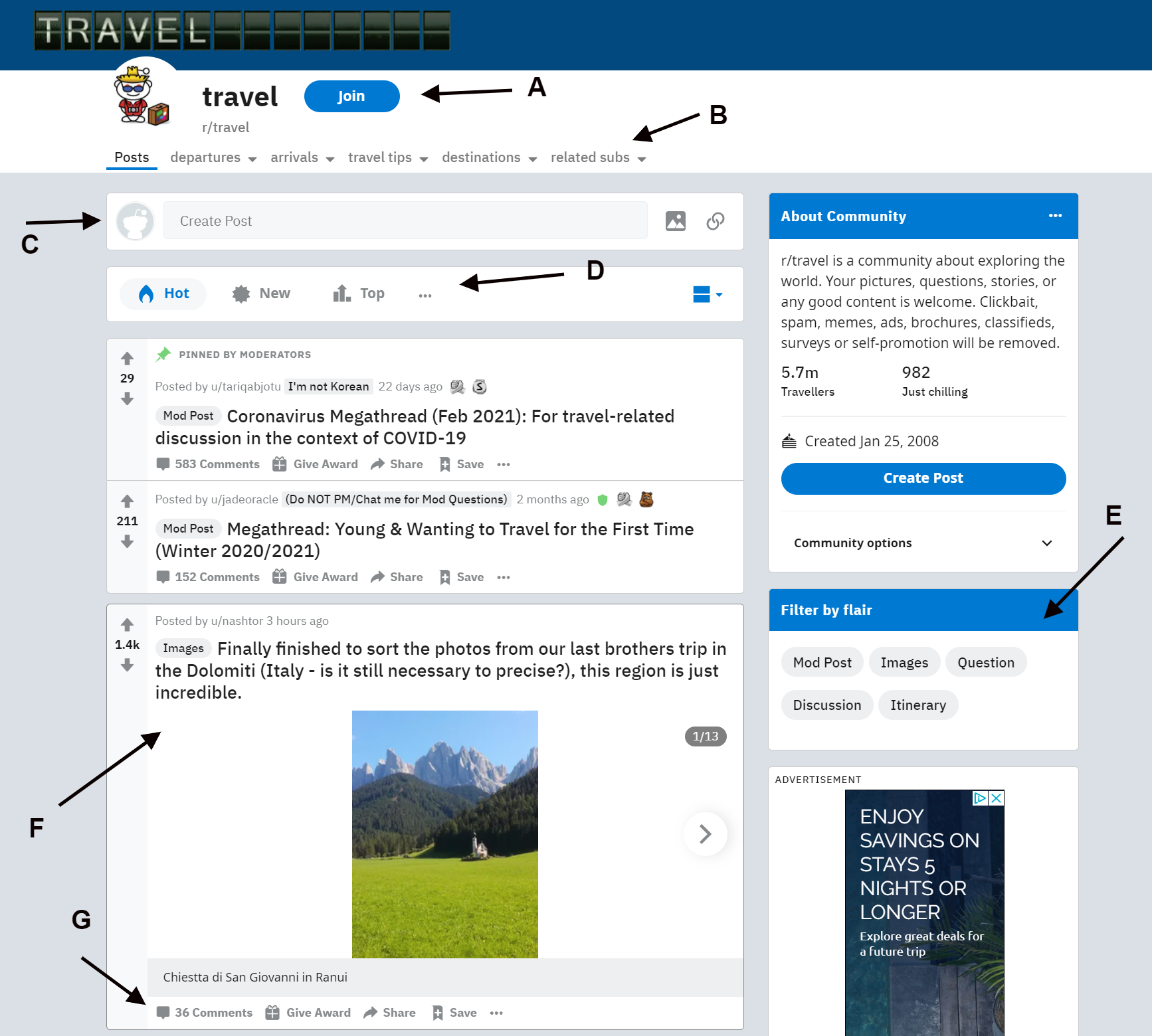
When you get to r/travel’s page, you will
A: Join the subreddit so that you will see updates from them on your Home Feed
B: Click “Related Subs” to see a list of subreddits that are affiliated and related to r/travel
C: Create your own post to add to the subreddit
D: Filter r/travel’s posts by Hot (popular), New, or Top (most popular over a customizable time range) with these buttons
E: Filter by the kind of post you are looking for using the flairs
F: Click on a post to see a full view (useful for posts with large photos or long strings of text)
G: Click on “Comments” to go to the comments section for this post
Not every subreddit looks the same, but each one should have these basic features (there may be differences in flairs and the availability of Related Subs)
Now that you know the lay of the land, you can look into the best ways to find new ideas. Ideas are better when found fresh, so start by sorting the subreddit by “Top,” and then sent the time frame as “This Month.”

Next, scroll through the posts, and click on anything that looks interesting. Generally, posts with more comments are better for new ideas because you can see that the post has affected people in some way. You want to capture that energy and maybe use it in future content.
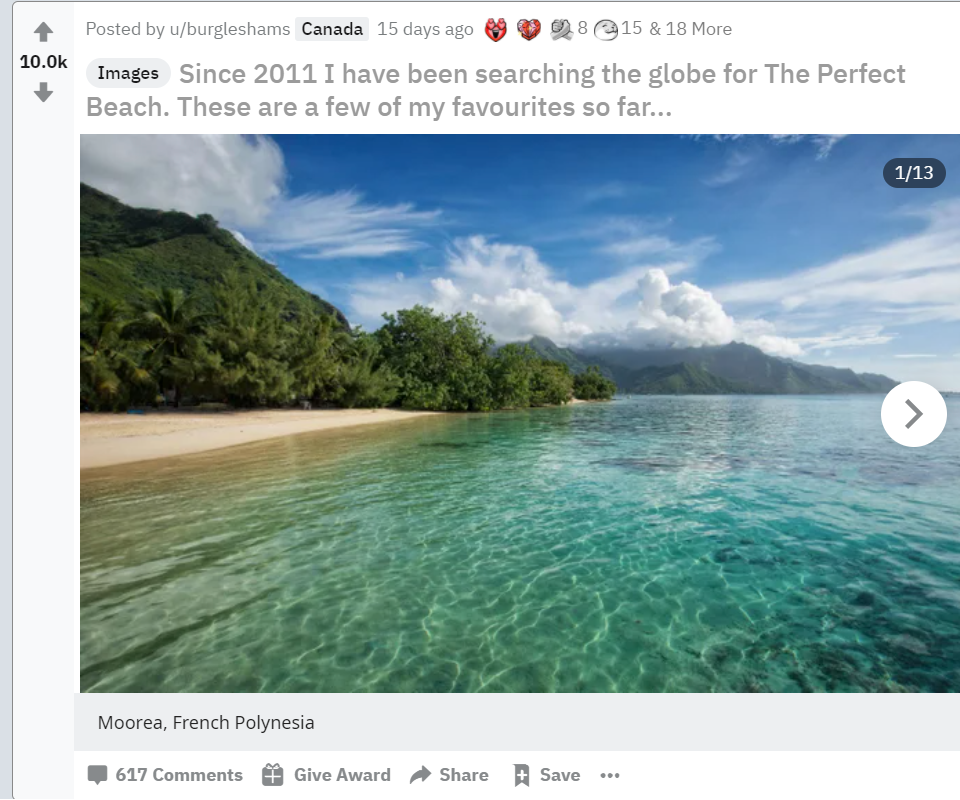
This post on the “Perfect Beach” ranks second over the last month, and it has 617 comments. When we look into those comments, you can see people recommending different beaches that they believe should make this person’s list:
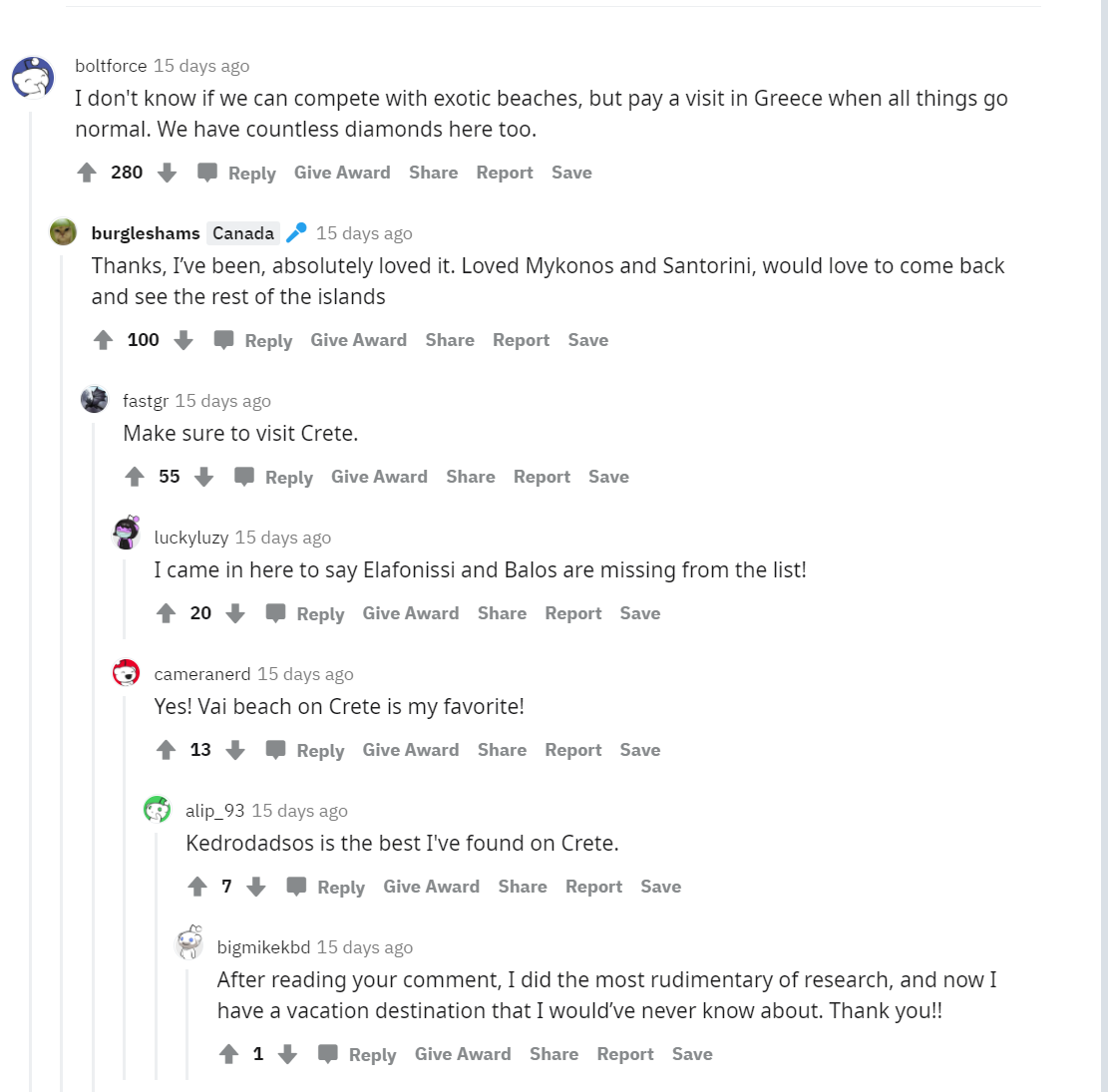
Comments often spiral off into tangents, where people comment on each other's comments; this is where things can get interesting. In this comment thread, “Boltforce” suggests that the post author should visit Greece, and then others chime in with their favorite Greek islands and beaches. What caught our eye was the final comment, where another user says they'd found a “vacation destination that I would’ve never know about.”
Based on this thread, you might consider creating your own post about the best beaches (because it obviously inspired debate and engagement). Or you could use this thread as inspiration to do a post on little-known Greek beaches people should try.
Make a habit of following subreddits where your kinds of readers hang out and discuss what is important to them. Although Reddit can be chaotic at times, often it's these raucous spaces that provide the strongest content ideas to brainstorm with.
2. Quora
Paying attention to the questions people are asking can inspire you to create content that people want. On the internet, Quora has quickly become one of the best places to discover what questions people are asking. Surfing through Quora questions (and the answers people give) is a well of inspiration when looking for that new, fresh angle that you want to explore for your readers.
How to Find Content Ideas on Quora
Start your Quora exploration by plugging in a keyword you might be interested in covering in your next piece of content, and then filter for posts in the last month. For this example, we have chosen cryptocurrencies:
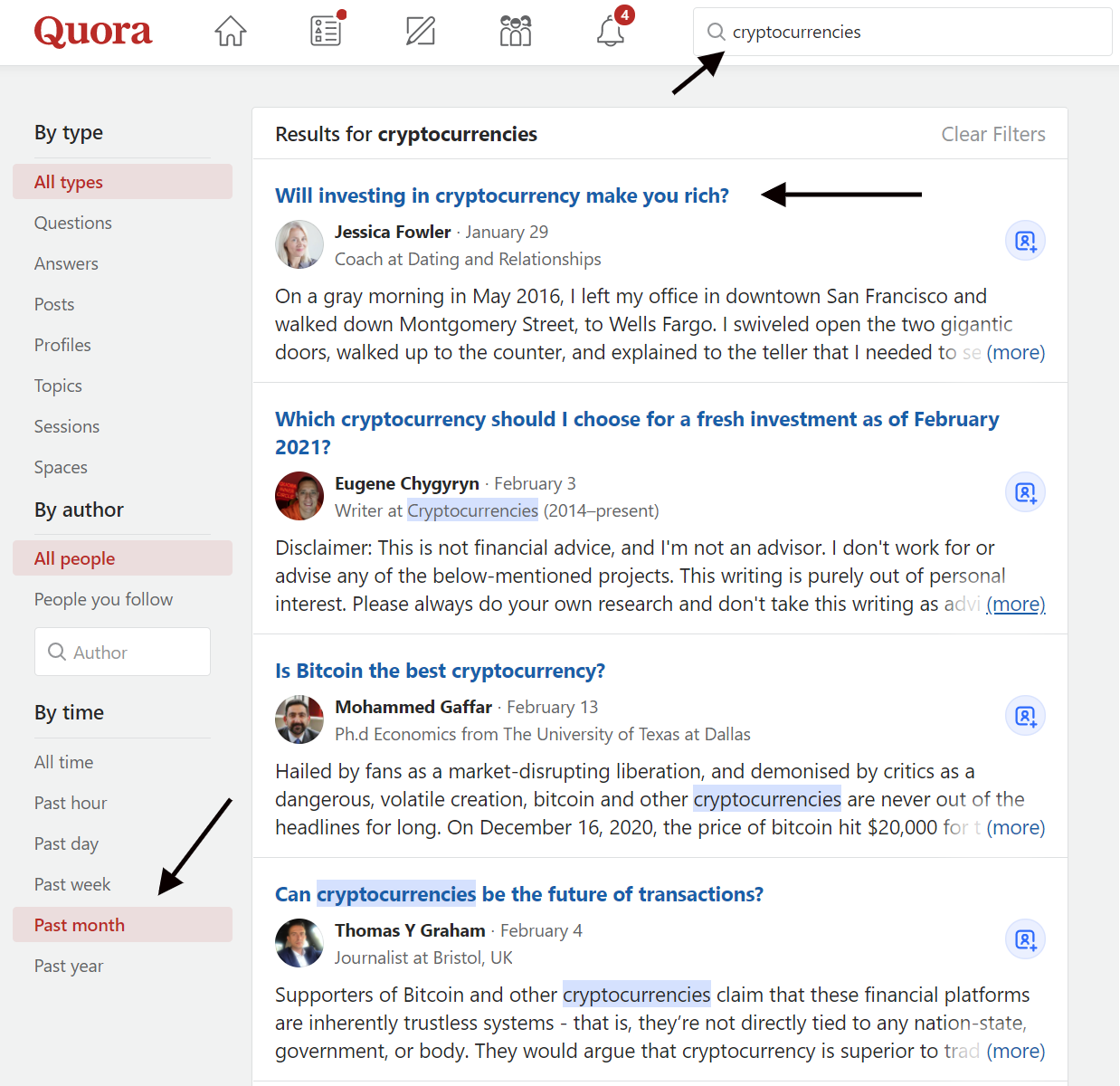
The next step is reading through the posts. Let’s take a look at this first entry, “Will investing in cryptocurrency make you rich?”
Next, scroll through the answers. Pay attention to the numbers of views, shares, and comments to see which answers are gaining traction.
The top answer for this particular question is a personal story of how one person put everything he had into a cryptocurrency and walked out a millionaire:
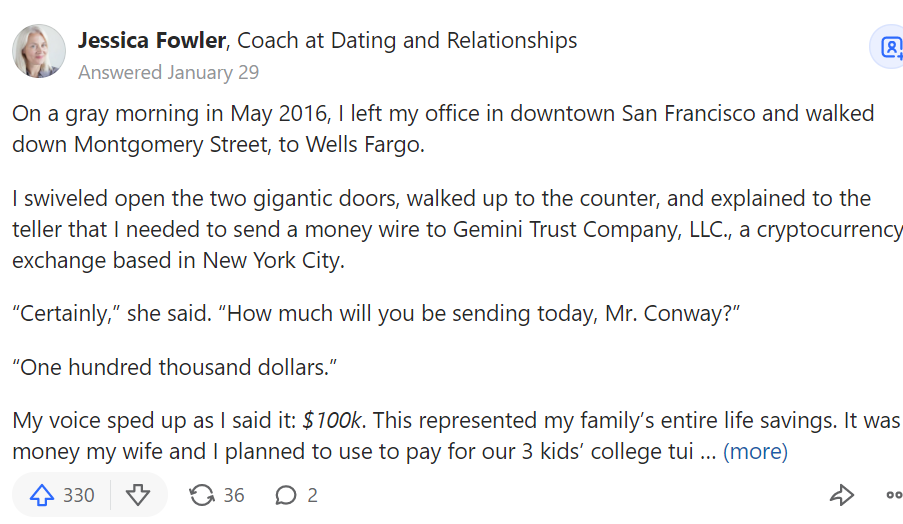
This post has been upvoted 330 times, shared 36 times, and commented on twice. What stands out here is that it is not analysis or data; it is a personal narrative. Perhaps this kind of storytelling could be effective for your own website.
Another answer that sticks out is this one from Arthur Tesfaye:
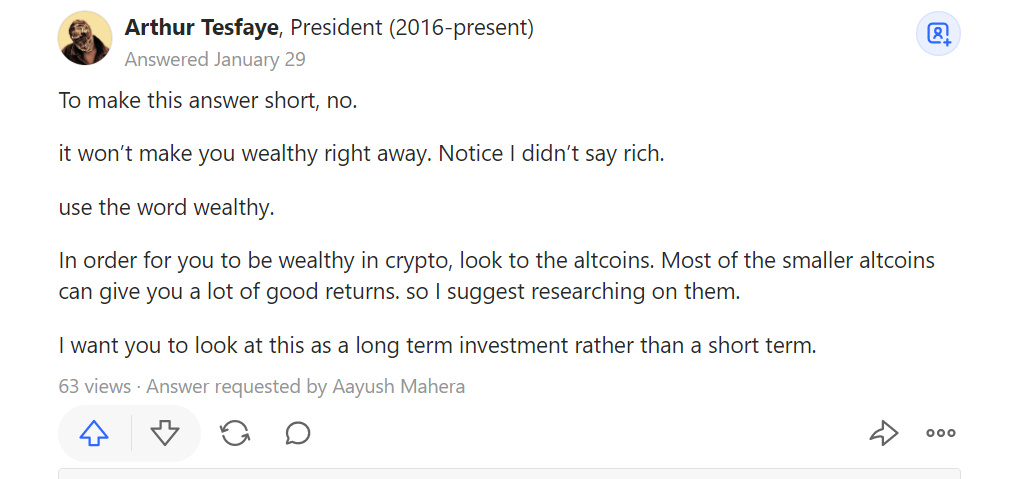
This post has 63 views, and it takes a contrarian point of view. Most people emphatically say that crypto will make you rich; Arthur says no, and he draws a distinction between becoming wealthy and becoming rich. This stance opens the door for more questions:
- What is the difference between being wealthy and being rich?
- Which one should I want?
- How can cryptocurrencies create wealth?
Be on the lookout for answers that cut against the grain of opinion. They are often a great starting point for thought-provoking articles that get your readers engaged in your content.
Overall, Quora can be an excellent resource for questions and answers that will spark your imagination. Scroll through what people are talking about and you’ll find a sea of inquiries that can keep your content calendar full for months.
3. Slack Groups
Slack has become a nearly indispensable tool for communication and collaboration for today’s businesses. But many people forget that Slack isn’t restricted to inner-office relationships. There is a whole other world of external Slack groups waiting to be discovered
.Slack groups are meeting places full of professionals waiting to discuss the topics you write about week in and week out. Finding the right Slack group can put you in touch with professional collaborators who can share tips, debate tricks, and spark inspiration for new content ideas.
How to Find Content Ideas on Slack
Ideas on Slack start with finding the right groups to join. Ideally, you want to find a place where other professionals like you go to discuss the nuances of what you do. So where can you find these groups?
One great place to check is Twitter. Search “Slack groups for [insert topic]” in the toolbar, and take a look through the feed to see what pops up.
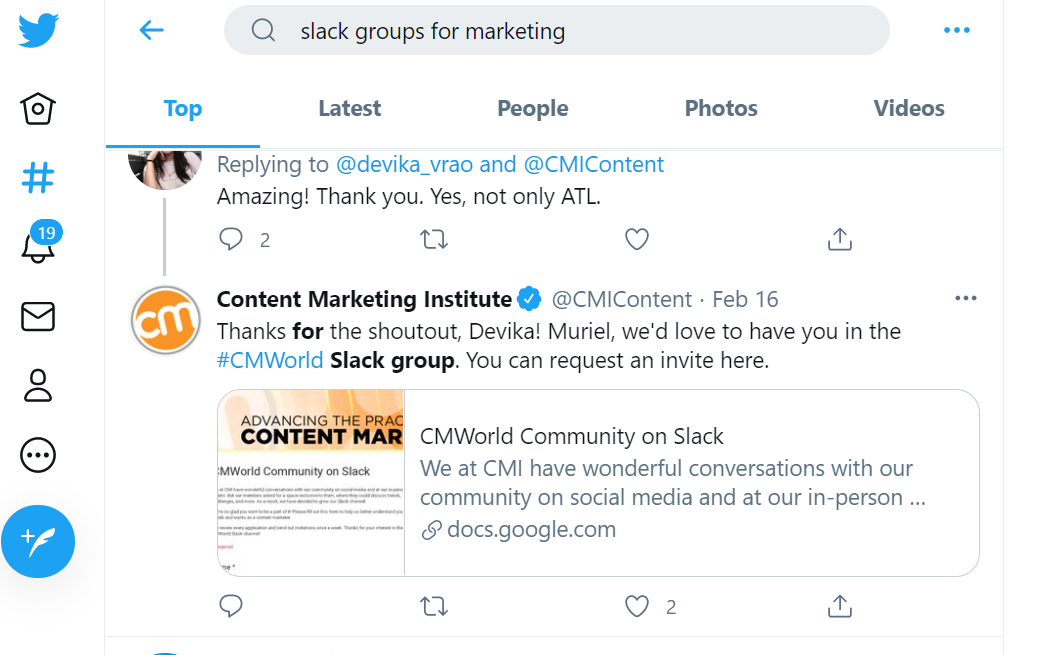
Another place to find relevant Slack groups is through a search engine like Google.
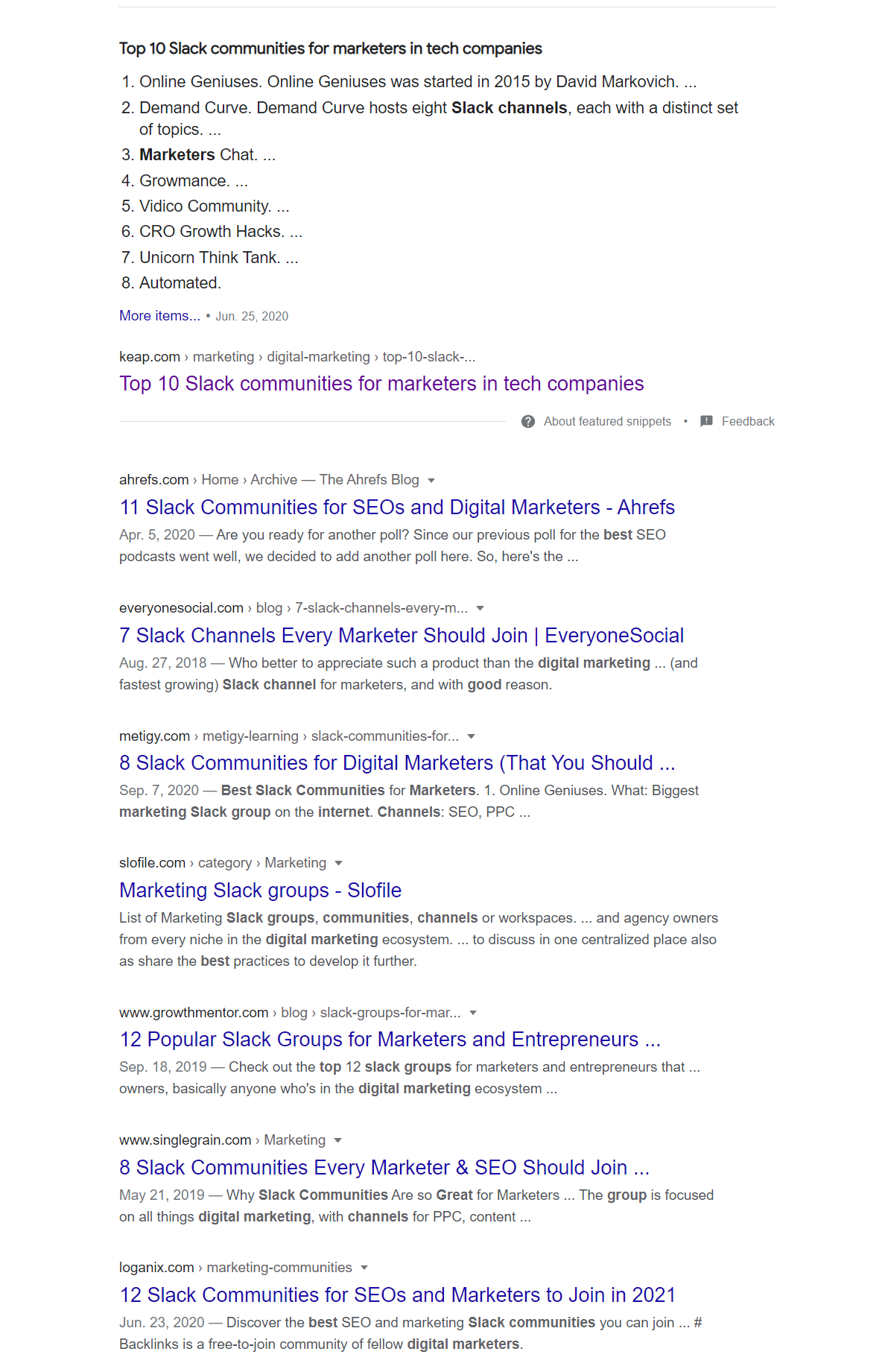
As you search, make a list of channels that seem relevant to you, and then begin applying for them. Most Slack channels will require you to apply, though it rarely takes much effort—just a check to make sure you legitimately want to be there.
Once you get into a Slack group, familiarize yourself with which channels are important to you, and determine whether it has the kinds of people and discussions you find stimulating. If you find the conversations interesting, there’s a good chance your readers will too.
In this exchange from the Slack group Online Geniuses, two people discuss what can make for a successful podcast on SEO:

As you can see, these discussions are constructive and insightful—not combative, as you often see on social media. Once you are in a group that you like, don’t be afraid to chime in with your own opinions. You don’t need to be actively posting every day, but it can be constructive to become a part of the community. The relationships you build may become opportunities not just for content creation but also for collaborations somewhere down the line.
For many of us, Slack is where we already spend a fair amount of time keeping up with company work. By adding additional groups to your Slack, you can easily take a break from work and find ideas among new professional colleagues.
4. LinkedIn
Since its founding in 2002, LinkedIn has become the Facebook for professionals. Many of us use it to connect with colleagues and look for new job opportunities. It can also be a powerful source of daily news and inspiration. Like Slack, LinkedIn can be a source for professional voices who can help you in your ideation process. It’s an especially great space for finding thought leaders posting about the newest developments and trends in your field—all fodder for great content.
How to Find Content Ideas on LinkedIn
The best way to use LinkedIn is to have a strong network of connections with people at the forefront of your field. You want your connections to include people who:
- Are spokespeople for the major companies in the field
- Are well-respected voices in the field
As you build up your network connections, your feed will become full of posts that should inform you of new changes and trends, as well as thoughtful articles that can help spark new ideas for your own content efforts.
The trick is to find these thought leaders who will supercharge your feed.
Start by connecting with professionals from your field who you actively follow on other social networks. Next, take a look on Google for lists of thought leaders other people have compiled, and ask these professionals if they’d like to connect.

You can also try looking at groups on LinkedIn, where you might connect with active posters.
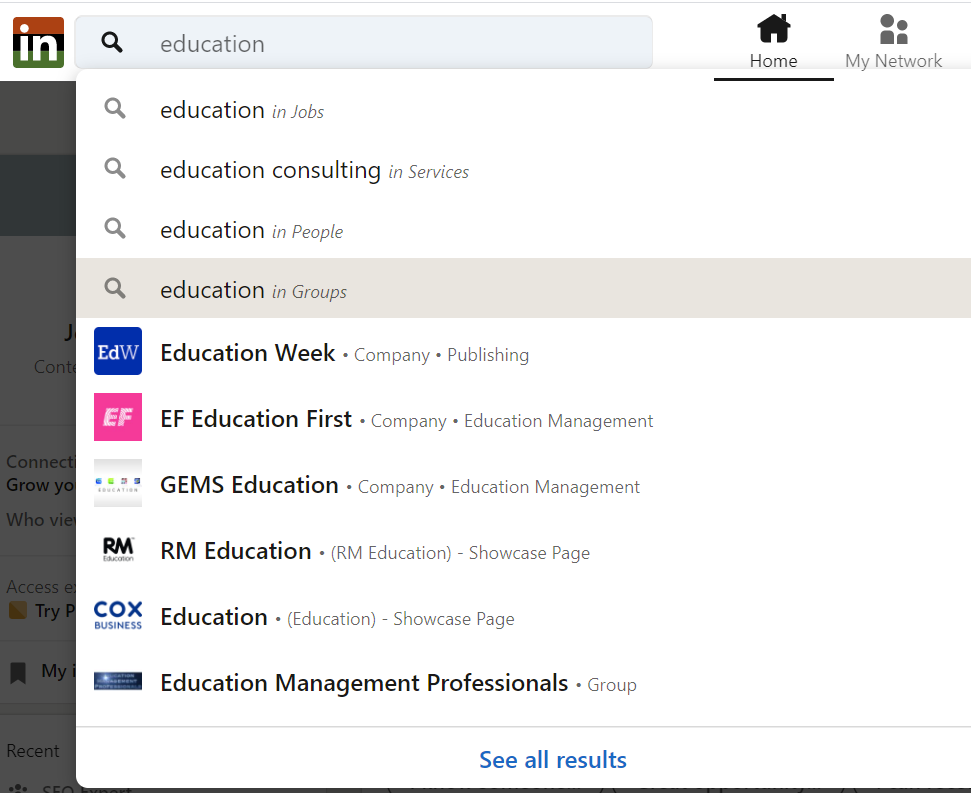
When you find potential people to follow, you can get an idea of what they post by going to their profile and clicking on “See all activity.”
Surf through their posts to see what they have to say. Look for people who post original data or insights that can help you learn and think in new ways.
To make it easier, try filtering by articles or posts to see what kind of content this person is posting or sharing.

In this case, we have found this post from Robyn, which looks at the potential damages that will be done to children by keeping them at home through the pandemic. If you were writing for an education blog, you could write a piece that looks at how parents can help children cope with closed schools in a constructive way. This topic brings out supercharged emotions and is an example of the kind of content that, when done right, can draw in readers and foster engagement.
As you find more and more people to connect with, you can build up a personal feed of industry leaders that can provide you with daily inspiration to draw from.
5. YouTube
YouTube is the second most used website globally, and it can expose you to millions of people and all of their ideas. Follow YouTubers in your sphere, and read through the comments on their YouTube videos to see what people want to learn.
How to Find Content Ideas on YouTube
Start by searching up a keyword that is related to the content that you want to write about. For this example, we have used “green tea” and filtered by upload date “This month”:
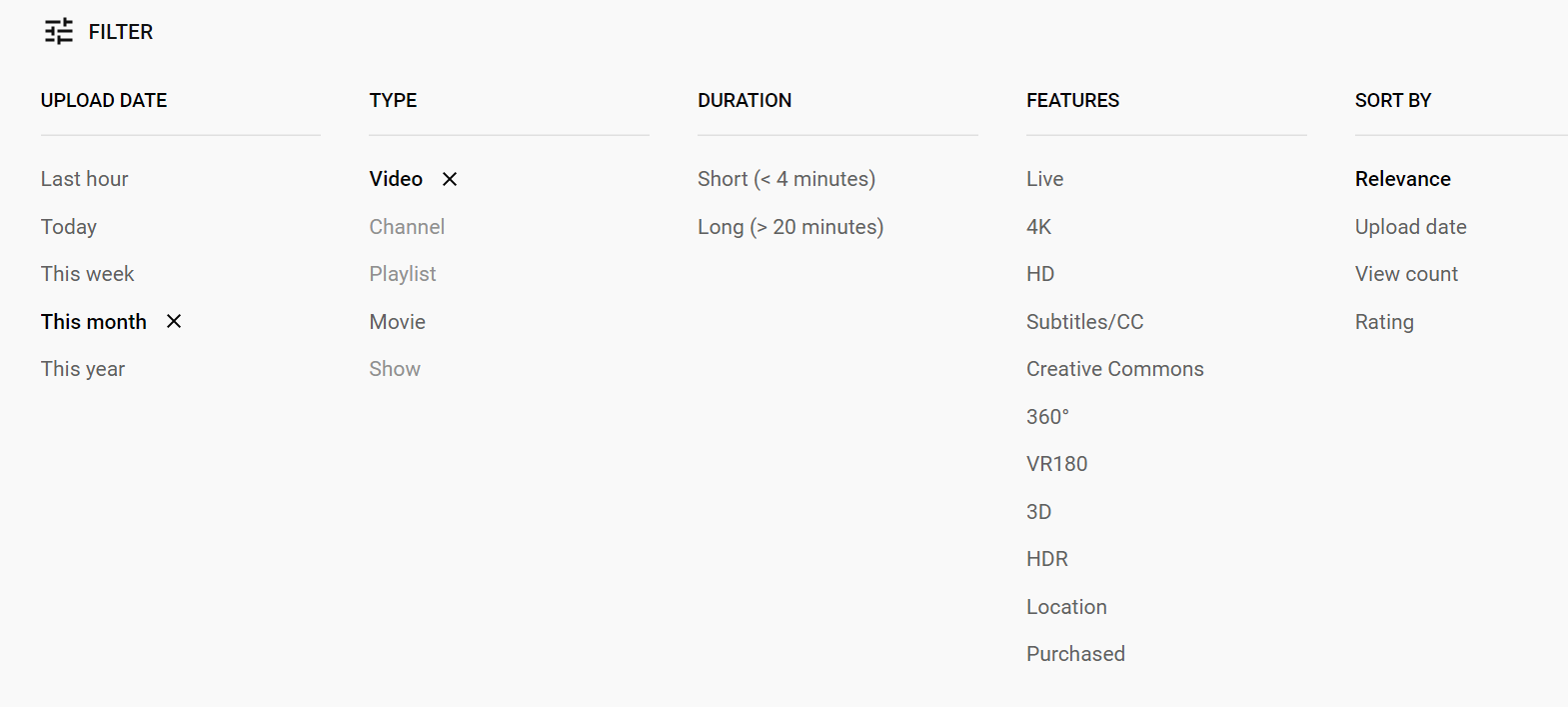
Take a look at the titles and view counts to find something that speaks to you and that others have engaged with:

Once you pick a video, scroll down and start to read the comments. From these comments, you should be able to determine what people found engaging about the video:


In these comments, we can see that some people were interested in the reason for rice in genmaicha tea and the impact of temperature on taste. Each of these topics could easily be spun into blog posts, videos, or new content. For example, you could write a post that answers the question of why rice is added to some teas. Is it because it is cheaper? Does it mask poorer quality leaves? Or does it add something to the flavor that you can’t get any other way?
If you find inspiration from the comments in a video, explore what other video content that YouTuber makes. If they make videos primarily in your sphere, follow them to stay up to date on what they make and to find more content ideas from commenters.
Great Content Ideas Require Regular Sourcing
If you want a constant stream of great ideas for your content, you need to put in the work. Get out there, find the best groups, and connect with the right people so you always have a ready source of inspiration. All you need to do is set aside a block of time each day to explore, engage, and refill your content plans.
Find great ideas by looking for them in places with people who are engaged and involved in the topics you love to talk about. By making it a habit to explore some of the websites that we have looked at today, you can find ideas that will help your content stand out and apart from the rest.

